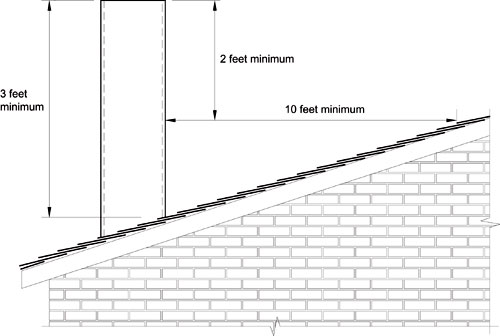When reroofing residential buildings, roofing contractors frequently encounter metal chimneys that pass through roof assemblies. During reroofing work, the condition of an exposed chimney portion can be assessed.
Chimneys are structures used to exhaust waste gases or byproducts produced by combustion. In the case of residences, combustion is created from a fire or appliance, such as a furnace or gas-fired hot-water heater. Waste gases travel through passages called flues, which are contained within a chimney. Because chimney exhaust affects the safety and health of building occupants, chimney construction is regulated by building codes. The codes contain requirements for the inspection, construction and maintenance of chimneys.
The 2003 International Fire Code requires the repair or replacement of any corroded or improperly supported metal chimney. If a roofing contractor believes a chimney needs repair or replacement, he should tell the building owner.
Roofing contractors should be aware that chimneys are addressed by several codes and codes sometimes refer to other codes. If a roofing contractor is asked to replace a metal chimney, he should refer to the 2003 International Residential Code (IRC), 2003 International Mechanical Code (IMC) and 2003 International Fuel Gas Code (IFGC). Metal chimneys are referenced in IMC and IFGC, but both codes refer to installation and construction requirements in the National Fire Protection Association's (NFPA's) NFPA 211—Standard for Chimneys, Fireplaces, Vents and Solid Fuel-burning Appliances, 2000 Edition (NFPA 211).
When repairing a chimney, one of the most important considerations is a chimney's height. When wind blows against a building and its roof, air turbulence is created. The waste gases from a chimney should not be expelled into this turbulence or downdraft may occur. Downdraft is when gases are forced down a chimney and back into a building. Therefore, the top of a chimney must extend past any areas of air turbulence.
IRC and NFPA 211 have simplified requirements to address minimum chimney heights. Both codes state chimneys must extend at least 3 feet (914 mm) above the highest point a chimney penetrates a roof and at least 2 feet (610 mm) higher than any portion of the building within a horizontal distance of 10 feet (3048 mm). (See the figure.)

IRC and NFPA 211 requirements for minimum chimney heights
NFPA 211 contains many other requirements, such as chimney clearances and appropriate flue system installation, as well as maintenance and inspection guidelines. NRCA encourages contractors to refer to NFPA 211 for more information. The document can be purchased from NFPA by calling (800) 344-3555 or accessing www.nfpa.org.
Joan P. Crowe is an NRCA manager of technical services.

